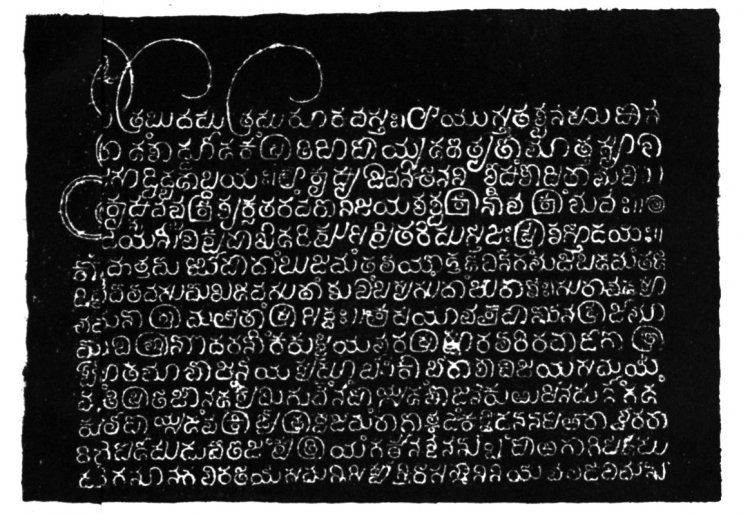Inscriptions and Chennakeswa Temple
Example Belur temple inscription in Sanskrit, written in Old Kannada script

Inscriptions: Historians have found 118 inscriptions in the temple complex, dated between 1117 CE to the 18th century, which provide a history of the temple, the grants made to the Chennakeshava temple for its upkeep and the repairs during later times.
An inscription found on the east wall near the north entrance of the temple's main mandapa (hall) states that Vishnuvardhana commissioned the temple for the god Vijayanarayana in 1117 CE. Some historians have interpreted this inscription as stating that the Chennakeshava Temple was completed in 1117 CE.
The Chennigaraya temple was built concurrently with the main temple, and the queen sponsored it. Narasimha I of the Hoysala dynasty made grants to the temple for its maintenance and operation. Ballala II in 1175 CE added temple buildings for kitchen and grain storage in the southeast corner, and a water tank in the northeast corner of the temple. The original temple was without a boundary wall. The main mandapa was also open for the devotees to view and appreciate the intricate carvings inside the temple.
For the security of the temple, a high wall was constructed around the temple, a wood-and-brick gateway and doors added by Somayya Danayaka during the rule of Veera Ballala III (1292–1343), as well as the open mandapa was covered with perforated stone screens. The new screens darkened the inside of the temple making it difficult to see the artwork but allowed enough light for the Darshana of the garbha griya. The temple was raided, damaged and its gateway was burnt down in a raid by a Muslim general Salar and his army working for Muhammed bin Tughlaq (1324-1351).
The temple was repaired by the Vijayanagara Empire under the sponsorship of Harihara II (1377–1404). In 1381, they added four granite pillars; in 1387, a gold plated kalasa was added by Malagarasa to a new tower above the sanctum; it added a new seven-storey brick gopurum in 1397 replacing the destroyed gateway. An Andal shrine, the Saumyanayaki shrine, the dipa-stambha at the entrance, the Rama and Narasimha shrines were added during the Vijayanagara Empire era.
The main temple had a shikhara (superstructure tower) but it is now missing and the temple looks flat. The original tower, suggest the inscriptions, was made of a combination of wood, brick and mortar. It was destroyed and rebuilt several times. The Vijayanagara Empire sponsored the addition of smaller shrines dedicated to goddesses and the Naganayakana mandapa within the temple complex.
These were constructed by collecting the war ruins of other demolished temples in the Belur area and reusing them. The temple premises were again damaged after the destruction of the Vijayanagara Empire by a coalition of Sultanates. The first repairs were done in 1709, followed by additions in 1717 and 1736.
The temple was repaired in 1774 by an officer of Hyder Ali during a period when Hyder Ali was the de facto ruler on behalf of the Wadiyar dynasty. In the late 19th-century, the collapsing tower above the sanctum was removed to save the lower levels and never replaced. In 1935, parts of the temple were cleaned and restored with financing by the Mysore government and grants by the Wadiyar dynasty.
The Chennigaraya shrine was rebuilt, new images of Ramanuja and Garuda were added along with many other facility improvements and repairs to the complex. These repairs were inscribed in stone for a historical record, just like earlier inscriptions.
What's Your Reaction?









































































